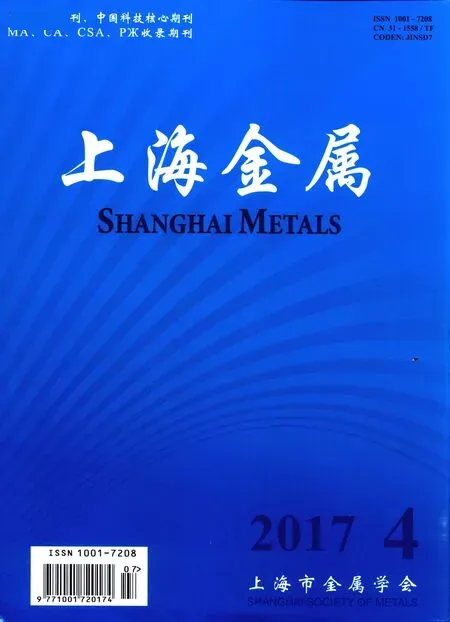退火温度对铁素体基轻质钢组织与力学性能的影响
董 超 许礽翀 钱灵锋 朱旭东 何燕霖 李 麟
(省部共建高品质特殊钢冶金与制备国家重点实验室、上海市钢铁冶金新技术开发应用重点实验室和上海大学材料科学与工程学院,上海 200072)
退火温度对铁素体基轻质钢组织与力学性能的影响
董 超 许礽翀 钱灵锋 朱旭东 何燕霖 李 麟
(省部共建高品质特殊钢冶金与制备国家重点实验室、上海市钢铁冶金新技术开发应用重点实验室和上海大学材料科学与工程学院,上海 200072)
为了满足汽车轻量化的要求,研制轻质钢迫在眉睫。设计了一种成分(质量分数,%)为Fe- 0.25C- 3.5Mn- 8Al的铁素体基轻质钢,研究了在不同热处理条件下,试验钢的显微组织与力学性能之间的关系。结果表明,冷轧试验钢具有较高的抗拉强度和屈服强度,但断后伸长率较低。退火处理后冷轧试验钢的性能有大幅改善,经过950 ℃×50 s+400 ℃×3 min处理后,其强塑积可达22 451 MPa·%。随着退火温度的升高,钢中奥氏体含量逐渐增多,κ- 碳化物逐渐溶解直至消失。拉伸变形后部分奥氏体发生转变,奥氏体稳定性参数与强塑积成正比。
铁素体基轻质钢 退火温度 κ碳化物 显微组织 力学性能
在现在和未来的汽车上,汽车的减重成为减少CO2排放和降低燃油消耗的关键手段。降低车身重量,即汽车轻量化,是降低燃油消耗的重要途径(约占50%以上)[1]。铁素体基轻质钢中铝含量较高(通常Al的质量分数>5%),其密度较低,且具有良好的力学性能,是较为理想的汽车轻量化材料。铁素体基轻质钢的相组成主要为铁素体基体上分布着奥氏体和κ- 碳化物[2]。为提高钢材的力学性能,需保证钢中具有一定含量的奥氏体[3]。通过合理的热处理,可以调控钢中的组织组成,使钢中κ- 碳化物溶解,同时具有较高含量的奥氏体。研究表明[4- 8],退火处理对于轻质钢组织的改善及性能的提升有关键的作用。基于此,本文研究了退火温度对含8%Al轻质钢的组织和力学性能的影响,并探讨了组织演变与力学性能之间的关系,从而为铁素体基轻质钢的开发提供参考。
1 试验材料与方法
试验钢在真空感应炉内进行冶炼,冶炼过程中充氩气保护,然后进行模铸获得100 kg的铸锭。其主要化学成分(质量分数,%)为:0.24 C,3.57 Mn,8 Al,Fe余量。将铸锭热轧至3 mm厚,初轧温度为1 050 ℃,终轧温度为900 ℃,然后将热轧板酸洗再冷轧至1.2 mm厚。利用盐浴炉将试样分别加热至820、850、910和950 ℃,并保温50 s,而后快冷至400 ℃保温3 min,随后空冷至室温。按GB/T 228.1—2010沿轧制方向切取标距为30 mm的非比例标准试样,采用ETM504C型电子万能试验机测量力学性能,变形速率为10-3s-1。试样经打磨抛光后用4%硝酸酒精侵蚀,利用扫描电子显微镜Hitachi S- 570进行组织观察。试样经打磨后,进行电解抛光,电解液为高氯酸/冰醋酸的混合溶液,抛光电压为30 V。利用X射线衍射仪Dmax- 2200分析钢中的奥氏体体积分数[9],奥氏体中含碳量根据式(1)计算得出[10]。
αγ=3.578+0.033 0XC+0.005 6XAl+
0.000 95XMn
(1)

2 试验结果与讨论
2.1 冷轧板的组织和性能
图1为试验钢冷轧后的SEM形貌和XRD图谱,可以看出,冷轧后钢中的组织为铁素体基体上分布着大量点状或细条状的κ- 碳化物及少量的奥氏体。沿轧向取样进行室温拉伸试验,测得其抗拉强度为1 067 MPa,屈服强度为1 048 MPa,断后伸长率仅3.5%,表现出明显的加工硬化。

图1 冷轧钢板的SEM形貌(a)及XRD图谱(b)Fig.1 SEM morphology (a) and XRD pattern(b) of the cold rolled steel sheet
2.2 退火温度对组织及力学性能的影响
图2是利用热力学计算软件Thermo- Calc计算的试验钢的垂直截面相图及相分数随温度变化图。由于铝的加入,钢中奥氏体相区缩小,两相区扩大,根据相分数随温度变化图,奥氏体析出温度为820 ℃,κ- 碳化物溶解温度为873 ℃。
图3为不同温度退火处理后试验钢显微组织的变化,可见退火后钢中κ- 碳化物数量明显减少。随着退火温度的升高,奥氏体含量逐渐增多,且奥氏体晶粒尺寸逐渐增大。
进一步对试验钢进行XRD物相分析,结果如图4所示。当退火温度高于850 ℃时,钢中检测不到κ- 碳化物,这表明在高于850 ℃退火后,钢中κ- 碳化物的含量很少或已完全溶解,这与Thermo- Calc计算结果相吻合。
图5为试验钢不同温度退火后的工程应力-工程应变曲线,表1为试验钢冷轧态及经不同温度退火后的力学性能测试结果。可见退火处理后,试验钢的抗拉强度和屈服强度均明显降低,但断后伸长率大幅提高。随着退火温度的升高,试验钢的抗拉强度和断后伸长率均呈逐渐升高趋势,经950 ℃退火后,强塑积达到最大值22 451 MPa·>%。
对比不含κ- 碳化物试验钢(910和950 ℃退火)和含有少量κ- 碳化物试验钢(820和850 ℃退火)的力学性能,可以发现,含有κ- 碳化物试验钢的屈服强度要高于不含κ- 碳化物的试验钢,但其断后伸长率和抗拉强度低于不含κ- 碳化物的试验钢。当退火温度低于850 ℃时,试验钢的工程应力- 工程应变曲线有明显的屈服平台,但当温度高于850 ℃时,则无明显的屈服平台。这主要是由于当退火温度高于850 ℃时,没有κ- 碳化物存在,基体组织由铁素体和奥氏体组成,因此没有形成屈服平台的条件。但当退火温度低于850 ℃时,κ- 碳化物可能会与位错产生交互作用,从而形成“柯氏气团”,对位错起到钉扎作用,从而具备了形成屈服平台的条件。

图2 试验钢的垂直截面相图(a)及相分数随温度变化图(b)Fig.2 Vertical section phase diagram (a) and the phase fraction changes with temperature (b) for the test steel

图3 在(a)820、(b)850、(c)910和(d)950 ℃退火后试验钢的SEM形貌Fig.3 SEM morphologies of the test steels after annealing at (a) 820,(b) 850,(c) 910,and (d) 950 ℃
对不同温度退火后试验钢拉伸前与断裂后的奥氏体含量进行XRD定量分析,结果如图6所示。可见在820 ℃退火后没有奥氏体存在,而退火温度高于850 ℃时均有奥氏体存在,且温度越高,奥氏体含量越高,在950 ℃退火时达到15.2%。拉伸断裂后钢中奥氏体含量减少,随着退火温度的升高,奥氏体含量减少的幅度逐渐增大,在950 ℃退火时达到最大为7.1%,这是由于在变形过程中钢中部分奥氏体转变成了马氏体所致。

图4 不同温度退火后试验钢的XRD图谱Fig.4 XRD patterns of the test steels after annealing at different temperatures

图5 不同温度退火后试验钢的工程应力- 工程 应变曲线Fig.5 Engineering stress- engineering strain curves of the test steels after annealing at different temperatures

表1 不同温度退火后试验钢的力学性能Table 1 Mechanical properties of the test steels after annealing at different temperatures
Chiro等[11]以奥氏体含量与奥氏体中碳含量的乘积作为奥氏体的稳定性参数(Vγ×Cγ),计算结果如表2所示,将其与强塑积作对比,发现奥氏体的稳定性参数与强塑积成正比关系,如图7所示。

图6 拉伸前与断裂后试验钢中奥氏体含量对比Fig.6 Comparison of volume fraction of austenite in the test steel before and after tensile test

表2 不同温度退火后试验钢的奥氏体含量及奥氏体中碳含量Table 2 Volume fraction of austenite and the content of carbon in the austenite of the test steels after annealing at different temperatures

图7 试验钢的强塑积与奥氏体稳定性 参数之间的关系Fig.7 Relationship between the product of elongation and strength and the austenitic stability parameter
由以上试验结果可以看出,试验钢的力学性能主要受钢中奥氏体的影响。当拉伸变形过程中奥氏体转变量较多、稳定性参数较大时,获得的力学性能较好。
3 结论
(1)铁素体基轻质钢冷轧后的组织由铁素体基体、κ- 碳化物和少量奥氏体组成,其抗拉强度为1 067 MPa,断后伸长率仅3.5%。
(2)退火处理后试验钢的组织和力学性能均得到改善。随着退火温度的升高,钢中κ- 碳化物逐渐溶解直至消失,奥氏体含量逐渐增多,抗拉强度和断后伸长率均呈逐渐增加的趋势,经950 ℃×50 s+400 ℃×3 min处理后,试验钢的强塑积达到最大值22 451 MPa·%。
(3)试验钢在拉伸过程中部分奥氏体转变为马氏体,其强塑积与奥氏体稳定性参数成正比。
[1] 李昊泽. 高铝高锰钢的组织及力学性能研究[D]. 沈阳:东北大学, 2012.
[2] LEE S W, DE COOMAN B C. Annealing temperature dependence of the tensile behavior of 10 pct Mn multi- phase TWIP- TRIP steel[J]. Metallurgical and Materials Transactions A, 2014, 45(13): 6039- 6052.
[3] SOHN S S, LEE B J, LEE S, et al. Effect of annealing temperature on microstructural modification and tensile properties in 0.35 C- 3.5 Mn- 5.8 Al lightweight steel[J]. Acta Materialia,
2013, 61(13): 5050- 5066.
[4] PARK S J, HEO Y U, CHOI Y H, et al. Effect of second phase on the deformation and fracture behavior of multiphase low- density steels[J]. JOM, 2014, 66(9): 1837- 1844.
[5] HAN S Y, SHIN S Y, LEE B J, et al. Effect of tempering time on microstructure, tensile properties, and deformation behavior of a ferritic light- weight steel[J]. Metallurgical and Materials Transactions A, 2013, 44(1): 235- 247.
[6] LEE S W, DE COOMAN B C. Effect of the intercritical annealing temperature on the mechanical properties of 10 Pct Mn multi- phase steel[J]. Metallurgical and Materials Transactions A, 2014, 45(11): 5009- 5016.
[7] HAN S Y, SHIN S Y, LEE H J, et al. Effects of annealing temperature on microstructure and tensile properties in ferritic lightweight steels[J]. Metallurgical and Materials Transactions A, 2012, 43(3): 843- 853.
[8] SHON S S, LEE B J, KWAK J H, et al. Effects of annealing treatment prior to cold rolling on the edge cracking phenomenon of ferritic lightweight steel[J]. Metallurgical and Materials Transactions A, 2014, 45(9): 3844- 3856.
[9] 黄继武, 李周. 多晶材料X射线衍射——实验原理、方法与应用[M].北京:冶金工业出版社, 2012.
[10] BABU S S, SPECHT E D, DAVID S A, et al. In- situ observations of lattice parameter fluctuations in austenite and transformation to bainite[J]. Metallurgical and Materials Transactions A: Physical Metallurgy and Materials Science, 2005, 36(12): 3281- 3289.
[11] CHIRO A D, ROOT J H, YUE S, The effect of microstructure on the strain- induced transformation of a Si- Mn bainitic steel[C] //Proc. 37th MWSP conf, Hamilton, Canada: ISS, 1995.
收修改稿日期:2016- 06- 05
EffectofAnnealingTemperatureonMicrostructureandMechanicalPropertiesofAFerriticLightweightSteel
Dong ChaoXu Rengchong Qian Lingfeng Zhu Xudong He Yanlin Li Lin
(State Key Laboratory of Advanced Special Steel & Shanghai Key Laboratory of Advanced Ferrometallurgy & School of Materials Science and Engineering, Shanghai University, Shanghai 200072, China)
To satisfy the requirement of lightweight vehicles, the research of lightweight steel is urgent. A ferritic lightweight steel having a composition of Fe- 0.25C- 3.5Mn- 8Al(mass fraction,%)was designed. Then the relationship between microstructure and mechanical properties of the test steel in different heat treatment conditions was investigated. The results showed that the cold- rolled steel had both high tensile strength and yield strength, but low elongation. After annealing treatment, the mechanical properties of cold rolled test steel were greatly improved. i.e., after annealing at 950 ℃ for 50 s, then rapidly cooling to 400 ℃ and holding for 3 min, the product of strength and elongation of the test steel could reach up to 22 451 MPa·%. With the increase of annealing temperature, the amount of austenite in the test steel increased, the κ- carbides resolved and disappeared gradually. Partial austenite transformed during tensile deformation, and the austenite stability parameter was directly proportional to the product of strength and elongation.
ferritic lightweight steel,annealing temperature,κ- carbide,microstructure,mechanical property
973资助项目(No.2010CB630802)
董超,男,主要从事汽车用先进高强钢的研究,Email: sdcjdc@126.com

